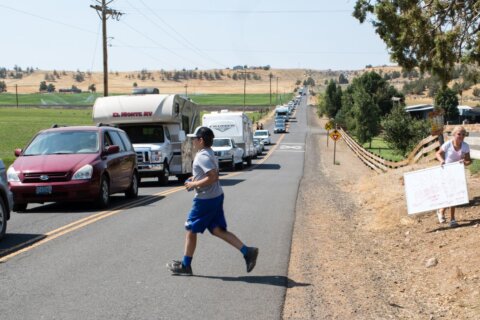WASHINGTON — When Pope Francis visited D.C. in September, he did more than offer blessings to true believers. He may have also delivered a miracle to the region with the worst traffic in the country.
A recent study found that the papal visit resulted in a relatively non-existent rush hour. The National Capital Region Transportation Planning Board used traffic speed data from INRIX to determine how fast people were travelling on Sept. 23 and Sept. 24, when the pope was in town.
During the papal visit, it took Interstate 395 motorists 12 minutes to get from the Springfield Interchange in Fairfax County, Virginia to the Potomac River. That tip that typically takes 44 minutes during the morning rush.
In Maryland, what’s usually a 38-minute trip on Interstate 270, from the Intercounty Connector to the Capital Beltway in Montgomery County, only took 11 minutes.
“I was really quite surprised by that,” says Ben Hampton, a transportation planner with the Transportation Planning Board. “Huge changes. This was a pretty extraordinary event.”
Unfortunately, as one lawmaker noted on Wednesday, the pope will not be permanently relocating to D.C. Nevertheless, Hampton says that some very valuable lessons could be learned from the papal visit.
Hampton said there was a 4 percent reduction in the number of people on the road and a 10 percent decrease in congestion. “Talking about what it will take to accomplish congestion reduction in the future, it might not take as much as people think in terms of how many cars we have to get off the road. A small reduction in traffic volume can result in a significant decrease in traffic congestion,” Hampton says.
There was an even greater impact between 8 and 9 a.m., the study found. During that time frame, the number of vehicles on local highways dropped by 2 percent; traffic congestion declined 27 percent.
The study’s author, Wenjing Pu, cautions against extrapolating long-term trends from the pope’s short visit.
“This is a very extraordinary event because the pope doesn’t visit us every month,” says Pu , a transportation engineer with the Transportation Planning Board. “People can only adjust their schedules to a certain degree. You cannot postpone your doctor appointments forever. In the long-term, the percentage reduction will not be that extreme. But there could be some good improvements if we expand telework or flexible hour policies for employees.”
The report recommends that more employers consider offering employees a four-day work week at 10 hours per day or staggering work schedules to allow a small percentage of employees to work shifts other than 8:30 a.m. to 5 p.m.







